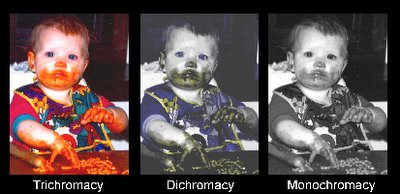 Wonder how the vision of some one who is colour-blind would be? Wonder how dull it would be for someone colour-blind to see the blue sky touching the deep-blue sea at horizon, when he is standing on a white sandy-beach on a sunny day in the Maldives? Well, I'm one of them. But honestly, I don’t know the difference, simply because I haven’t experienced what others see. I knew I’m colour-blind very recently when a doctor confirmed that I am have a "partial colour-blindness". Then only I realised that it was something wrong with my eyes that always made my “flame-test” results wrong. I bought three pairs of trousers on three different occasions, which I thought were of different colours, but then later I realised all those three were green when my friend told me about it. It also made me realise why my classmates always teased me when I was a kid. The other kids found it is funny that the "stick-people" I drew had green faces. I tried my best to learn the colours, but then I found that I always confused similar colours such as green with red, or brown, blue with purple and yellow with light-green.
Wonder how the vision of some one who is colour-blind would be? Wonder how dull it would be for someone colour-blind to see the blue sky touching the deep-blue sea at horizon, when he is standing on a white sandy-beach on a sunny day in the Maldives? Well, I'm one of them. But honestly, I don’t know the difference, simply because I haven’t experienced what others see. I knew I’m colour-blind very recently when a doctor confirmed that I am have a "partial colour-blindness". Then only I realised that it was something wrong with my eyes that always made my “flame-test” results wrong. I bought three pairs of trousers on three different occasions, which I thought were of different colours, but then later I realised all those three were green when my friend told me about it. It also made me realise why my classmates always teased me when I was a kid. The other kids found it is funny that the "stick-people" I drew had green faces. I tried my best to learn the colours, but then I found that I always confused similar colours such as green with red, or brown, blue with purple and yellow with light-green.Now let’s look at an explanation of how colour-blindness occurs!
The perception of colour can be exhilarating and motivational. Certain colours give us information such as a red sign of traffic lights when driving. Some colours can calm us such as a room painted in light-blue. While some other colours can improve our concentration such as yellow. The perception of colours can be varied. Many men (approximately 10%) perceive colours inaccurately. The following information will help to give you a background in understanding colour vision.
There are many types of cells inside of the eye which help in colour vision. Cells which help us to perceive light can generally be divided into cones and rods. Cone cells help us to see colours and during daylight. Rod cells are generally more responsible for night-time vision.There are generally three types of cone cells. They include "red," "green," and "blue." cells. In a normal individual all three types are present. The scientific name for when we have all three receptors and normal function occurs is trichromaticity. If one type of receptor is not working properly, the condition is called anomalous trichromaticity. This person will have reduced sensitivity to some colours. For example, they might be able to perceive all except for green. It might be duller than normal. This is termed colour deficiency, not colour-blindness.
A person that has one of the three pigments missing is called a "dichromat." This means one of the three primary pigments (red, green and blue) is actually missing. This results in no perception for the missing pigment. Again this is called colour deficiency, not colour-blindness.
It is very rare to be completely colour-blind or a monochromat (sometimes called achromatopsia). Unfortunately the term colour-blindness is often wrongly used when colour vision is slightly deficient.



3 comments:
awww..but i thot..colour blind people see red colour as green and green as red, right? and that is y they are not given lisense to drive even.. :S
and i got 100% correct for the colour test :D yay! hehe..
Lol...I've got license...And i know how to identify the red a green lights...caz they are at two different levels...Plus i follow the crowds when im at traffic lights...Just kidding... I can see colours, quite different from the way u see it though!
Post a Comment